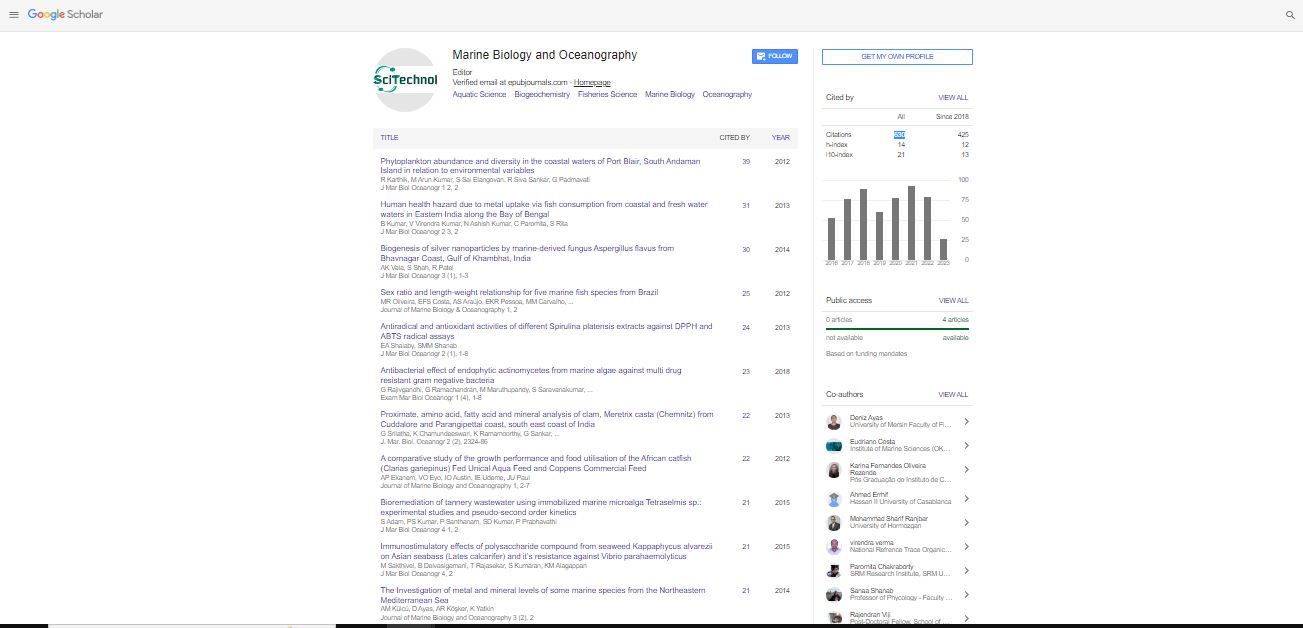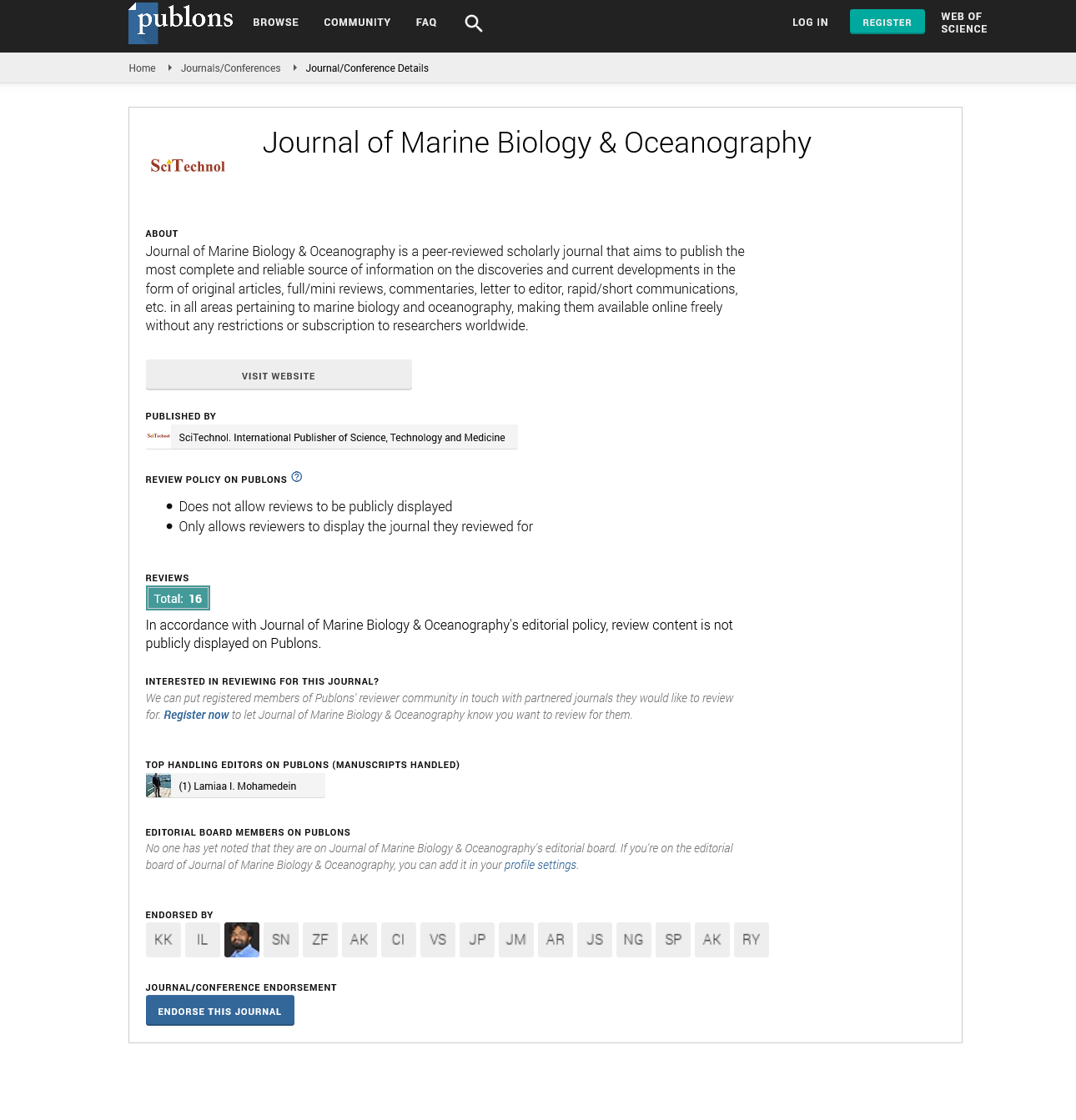Commentary, J Mar Biol Oceanogr Vol: 12 Issue: 5
Examining the Methods and Technologies in Marine Engineering
Zaonh Shang*
1Department of Environmental Science and Engineering, Ocean University of China, Qingdao, China
*Corresponding Author: Zaonh Shang,
Department of Environmental Science
and Engineering, Ocean University of China, Qingdao, China
E-mail: zaonh_shangouc@22.cn
Received date: 20 September, 2023, Manuscript No. JMBO-23-121775;
Editor assigned date: 22 September, 2023, PreQC No. JMBO-23-121775 (PQ);
Reviewed date: 06 October, 2023, QC No. JMBO-23-121775;
Revised date: 13 October, 2023, Manuscript No. JMBO-23-121775 (R);
Published date: 20 October, 2023, DOI: 10.4172/2324-8661.1000291
Citation: Shang Z (2023) Examining the Methods and Technologies in Marine Engineering. J Mar Biol Oceanogr 12:5.
Description
Marine engineering, a field lies at the intersection of engineering and naval architecture, plays a pivotal role in shaping the future of maritime industries. In recent years, advancements in methods and technologies have propelled marine engineering into an era of innovation and efficiency. Ship Design and Hydrodynamics is the core of marine engineering is the art and science of ship design. Advances in Computational Fluid Dynamics (CFD) and modeling software have revolutionized the way marine engineers design vessels. These tools allow for intricate simulations of a ship's behavior under various conditions, enabling engineers to optimize hull shapes for improved fuel efficiency and stability. The examination of hydrodynamics through sophisticated simulations has become an essential component in the pursuit of vessels that are not only faster but also more environmentally friendly.
The propulsion systems of ships have witnessed a paradigm shift with the integration of advanced technologies. Traditional diesel engines are being augmented or replaced by more sustainable alternatives, such as Liquefied Natural Gas (LNG) or hybrid systems incorporating electric propulsion. The use of azimuth thrusters and pod propulsion systems enhances maneuverability, making vessels more responsive in challenging maritime environments. These technologies not only improve energy efficiency but also contribute to reducing the environmental footprint of marine operations.
The period of smart technologies has reached the high seas. Automation and the integration of Artificial Intelligence (AI) are transforming the operational landscape of ships. Automated navigation systems, predictive maintenance through sensors, and machine learning algorithms enhance decision-making processes, improve safety, and optimize fuel consumption. The examination of these technologies demonstrates a move toward more autonomous and connected vessels, resulting a new era in the efficiency and safety of maritime transportation.
With the global focus on sustainability, marine engineers are at the forefront of developing eco-friendly solutions for the industry. From the implementation of wind-assisted propulsion systems to the exploration of solar energy and hydrogen fuel cells, the examination of sustainable technologies is reshaping the maritime sector. As the industry aligns with international efforts to reduce emissions, the methods and technologies developed by marine engineers are essential in promoting a more environmentally responsible and sustainable future for maritime transportation.
The safety of maritime operations is paramount, and advancements in technology have greatly enhanced emergency response capabilities. Real-time monitoring systems, satellite communication, and advanced sensors contribute to early detection of potential issues, allowing for proactive measures to reduce risks. The examination of safety measures encompasses not only technological innovations but also comprehensive training programs for crews, ensuring that the human element remains an integral part of maritime safety.
Marine engineering extends beyond the visible surface, with underwater robotics and inspection technologies playing a vital role in maintenance and exploration. Remotely Operated Vehicles (ROVs) equipped with cameras and sensors allow for the examination of subsea structures, pipelines, and ship hulls. These technologies enhance the efficiency of inspections and repairs, reducing the need for costly and time-consuming dry-docking.
The concept of a digital twin, a virtual replica of a physical object or system, has found its way into marine engineering. Ships are now being equipped with digital twin technologies that provide real-time data on performance, condition, and maintenance requirements. This examination of digital twin technology facilitates predictive maintenance, optimizing operational efficiency and minimizing downtime.
Conclusion
The methods and technologies in marine engineering are undergoing a transformative evolution, driven by the quest for efficiency, sustainability, and safety. From the design of ships with advanced hydrodynamics to the integration of smart technologies and the push for sustainability, the examination of these innovations reveals a dynamic field at the forefront of technological progress. As marine engineers continue to push the boundaries of what is possible, the future providing a maritime industry that is not only more efficient and technologically advanced but also more environmentally conscious and sustainable.
 Spanish
Spanish  Chinese
Chinese  Russian
Russian  German
German  French
French  Japanese
Japanese  Portuguese
Portuguese  Hindi
Hindi 
